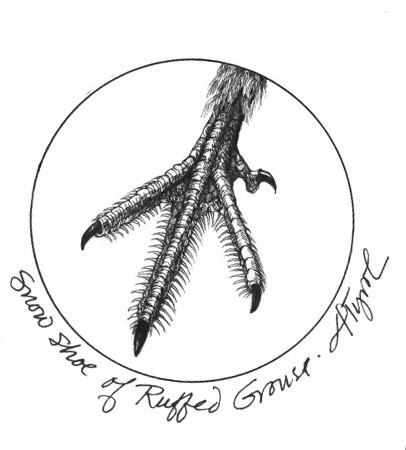
Winter in Northern New England is challenging for birds that don’t migrate south. To survive, a bird must find adequate food, refuge from wind and cold, and protection from predators.
Overwintering species have various tricks for survival. The downy woodpecker excavates cavities in trees for shelter. Black-capped chickadees lower their nighttime body temperature to save energy. American goldfinches, which have about 1,000 feathers during the breeding season, molt in late summer and grow about 2,000 new ones for winter insulation.
When it comes to winter adaptations, however, it’s tough to beat the ruffed grouse. It has all kinds of adaptations, including the ability to hide out under deep snow.
A ruffed grouse, which is about the size of a small chicken, is well camouflaged with mottled brown feathers that blend with the forest floor during spring, summer and fall. In these seasons they spend much of their time eating more than 100 kinds of plants, mostly leafy ground vegetation. In winter, however, with most of these food sources buried by snow, the ruffed grouse changes its diet, moving to buds, twigs and catkins.
By far the most sought-after winter foods for grouse are the sugar and protein-rich flower buds of trembling aspen. Grouse also consume the buds and catkins of big-toothed aspens, birches, alder, willow, beaked hazelnut and ironwood. To digest woody material, they rely on a gizzard, a part of their digestive tract, where with the help of tiny pebbles that they swallowed, they are able to break down the tough cellulose fibers.
Ruffed grouse are poor at storing fat. That means they must eat large amounts of food daily, usually at dawn and dusk. But they must be careful to avoid lingering while feeding, as they’re exposed to predators while feeding on the buds of leafless trees. Red-tailed hawks, goshawks and great-horned owls are quick to spot them.
The ruffed grouse does have a way of minimizing risk while dining. They eat fast. In 20 minutes a grouse can swallow enough buds to make it through the day. It is able to do this thanks to its crop, a wide portion of the esophagus, which acts as a storage chamber for consumed food. With a loaded crop, the grouse flies to a protected area, where it can safely digest its meal.
Ruffed grouse have other physical and behavioral characteristics that help in winter. In September, fleshy projections – pectinations—begin growing on the sides of their toes. These comb-like nubs, which fall off in spring, increase the surface area of the foot. Working like snowshoes, they allow the bird to walk across snow with less effort. Pectinations also give the grouse a better grip on an icy branch where it might perch while feeding.
A grouse, in cold weather, develops special feathers that extend down its beak, covering its nostrils, allowing the bird to breathe in warmer air. Ruffed grouse also have feathers partially covering and insulating their legs.
The ruffed grouse is famous for its winter roosting routine, commonly referred to as “snow roosting.” With no snow, or just a few inches of it, the bird is likely to seek protection in conifer stands. If the snow is soft and a foot or more deep, however, the grouse is likely to spend the night in an insulated, air-filled snow tunnel. The grouse builds this tunnel by first plunging from a tree into the snow. Then with its wings and feet the grouse extends the tunnel, sometimes to as much as 10 feet. Recent research suggests that the temperature in a snow hideaway may warm to 32 degrees Fahrenheit and that it rarely falls below 20 degrees—even when it is much colder outside. This tunnel helps the grouse conserve energy, so it needs less food. Less time spent in the open also means less time being exposed to predators.
A ruffed grouse exits its tunnel with a flap of wings and burst of snow that will scare the daylights out of any snowshoer or skier happening by. When in the woods, be prepared for such a surprise, while also looking for wing impressions in the snow, sure signs of a quick departure for a quick breakfast.


Discussion *